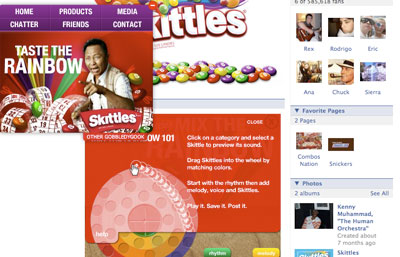Skittles skittles skittles skittles skittles skittles skittles skittles skittles skittles skittles skittles skittles skittles skittles skittles skittles skittles skittles skittles skittles skittles skittles skittles skittles skittles skittles skittles skittles skittles skittles skittles skittles skittles skittles skittles

There are few things I enjoy more than marketing initiatives that generate press. From Gawker, brought to my attention by James and Aliza:
It would be hard to come up with a cheaper ad campaign: Mars’ new
fruit-candy promotion consists of redirecting its homepage to a Twitter
search for “Skittles.” Successful? Wildly.A
Skittles logo floats on top of the Twitter page, and sometimes Mars
redirects to YouTube or Facebook instead of Twitter. The campaign is
about as bargain-basement as you can get: Mars doesn’t need a TV buy,
ad agency or even much Web design work.And Twitter users are, as
planned, including the word “Skittles” in their posts in order to have
the honor of appearing on the Skittles.com home page.…In other
words, Mars has reduced its advertising nearly, but not quite all the
way, to mindless repetition of a single word.
Not surprisingly, marketers (marketeers?) are skeptical of the risks Skittles is taking by hardly monitoring content about their product:
Other experts say Skittles is taking the wrong approach to social
media. Instead of encouraging teens to have a conversation about
Skittles, it is encouraging false conversations about the brand, says
Shiv Singh, vice president and global social-media lead at Razorfish, a
digital-marketing firm owned by Microsoft. “Everyone is having a field
day and writing ‘Skittles’ on Twitter just to get attention,” he says.Sure enough, the site became the target of Internet pranks on
Monday. The way the “Chatter” portion of the Skittles.com site is
built, any Twitter user who mentions the word “Skittles” is featured on
the homepage.At least one Web site has been launched by pranksters encouraging
Web users to post negative comments about the candy. The comments range
from the thoughtful to the outlandish. “Skittles taste terrible. If you
eat Skittles you support killing kittens and puppies,” wrote a Twitter
user named kingshane. (from The Wall Street Journal)
I personally think this demonstrates Skittles’ complete understanding of social media (” “), runaway negative commentary and all. There is nothing more nails-on-the-chalkboard than arts organizations’ unnatural attempts to utilize Facebook, Twitter, MySpace, YouTube, etc.. We Should Have a Blog, someone says at a staff meeting, and a blog on an organization’s website on which press releases are posted once a month is launched. A marketing director’s 15-year-old-son mentions “Facebook” at the dinner table, and suddenly there’s an organization page devoid of voice. These sites need to be utilized the way they are intended to be utilized; they won’t change for you! Identify what you specifically hope to achieve marketing-wise – beyond simply getting young butts in seats – and then figure out which sites fit best with your organization’s unique personality and needs. You shouldn’t launch a YouTube channel just because the ballet across the street has one; maybe Twitter works better for you. [“If the ballet company across the street told you to jump off a bridge, would you do it?”] And if there’s no one on staff who can naturally participate in so-called social media, reach the youth of America some other way. Or, better yet, see if that marketing director’s son needs an after-school job.
UPDATE, 5:30 pm on Thursday: Greg Sandow tells me that conductor Michael Christie is tweeting about how bad orchestras’ Twitter pages are! Christie tweets, “Recently agreed
to follow a few orchestras. Not sure how I feel about be bombarded with
marketing stuff rather than people’s thoughts.” and then “Atlanta has picture of Spano. I want to hear from him not marketing people.” I stand impressed by Christie’s candor. Speaking of which, he’s also just commented on a post over on Greg’s blog, which is a dangerous game as we learned from Cleveland. A reader just asked if the Brooklyn Philharmonic has been paying him (!!!); someone page a publicist!

I actually thought that it was a great idea to generate buzz around the brand..
I have yet to see a useful Facebook or MySpace page done by a performing arts organization. Most of them are out of date, and a mis-appropriation of the social networking medium. I would like to be proved wrong, as there has to be a way.
I find it difficult to reduce most art to some sort of “brand”. Bayer Aspirin is a brand. It is boring, consistently the same boring thing, and sold through mindless repetitiveness purchased with multi million dolllar budgets. Go ahead, build up your local performing arts group as a “brand”, and then present a stinko show. Your brand is ruined.
Promote each show as a unique experience and one bad one will not destroy everything you have built up. Promoting the arts is a different animal than WalMart.
And thank god for that.
I’ve really been enjoying Twittering – and Facebooking – for my own theatre company (shameless hussy productions) and for the arts school I work for (UBC Department of Theatre and Film). It’s the perfect way to reach young audiences.
The opportunity to have a global (and local) conversation about the arts on Twitter is particularly engaging. Another advantage of participating in the Twitterverse is that I’m reading more about the arts internationally than I ever have. I couldn’t agree more about how important it is to have a “voice” in these mediums. Gee, it sure comes in handy to have those improvisational skills now.
And then there’s the Elephant in the room. It’s more than a bit unnerving that the media as we know it is dying – but I couldn’t be more thrilled about the prospect of getting out from under the marketing thumb of overpriced print ads in mediocre newspapers.
How tweet it is!